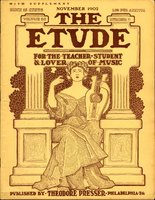BY WILLIAM BENBOW
"Who's Who" is the name of a publication giving short biographical sketches of the most successful Americans. The edition of 1900 contains 8602 names.
In the Popular Science Monthly Professor Dexter has made "A Study of Modern Success" based upon the data contained in the 1900 edition. His deductions in regard to the relative standing of musicians is timely and interesting. He classifies the professions represented into actor, artist, author, business, clergyman, college professor, congressman, editor, educator, engineer, financier, inventor, lawyer, librarian, physician, musician, sailor, scientist, soldier, and statesman.
He collated and compared the data furnished by these sketches, which are rather limited, to find the relative probability of achieving early distinction in the different callings. In that respect he finds that the musician outruns all other rivals, as thirty-four per cent, of the most famous musicians attain reputation at an early age; that is, below forty.
The next point he wished to establish was the average ages of persons of distinction in the given professions. According to his compilation, forty-five years is the average for the musician of note. In trying to account for the comparatively earlier eminence of the musician Professor Dexter thinks it is not so hard to understand when "we recall the infant prodigies who frequently figure on our billboards, or consider that Nature has in most cases contributed more largely to his success than has nurture."
The present writer is inclined to think he has laid too great an emphasis on the infant prodigy, for is it not a pretty well established fact that a good proportion of such prodigies never comes to fruition? And, as to nurture, we submit that the prodigies who gained eminence later have also been prodigies of assiduity in study; in other words, nurture. Liszt was certainly an infant prodigy, but consider the hours and days he had to practice and study while yet a mere boy, and compare it with the way other boys of his age were probably using the same time, even those who subsequently became illustrious.
As to the balance between Nature and nurture, it will be instructive to compare the musician with the artist. The average percentage for artists who have gained early fame is only fifteen, while the average age of eminent artists is forty-five, the same as for musicians. Although the infant artist does not so "frequently figure on our bill-boards," yet it is a nice question whether the percentage of famous artists who displayed precocity is not as great as in the case of the musicians. True, we do not see so much of the youthful artist, because he does not need to stand by his picture in the exhibition, while the musician must be in personal evidence at the piano or with the violin.
Eliminate the personal element and have Kubelik, for example, play from behind the scenes. What a difference there would be in the audience and in his popularity, two points that help to give him "early distinction"! The manager estimates very carefully the "profitable publicity" of the young artists' appearance in persona.
As to educational preparation, the following results were deduced: Fifty-nine per cent. of the noted musicians are shown to have had no education above the high school; seven per cent. have had a college education; two per cent. have had a professional education, ranking the same as a divinity-school course; thirty- three per cent. were educated entirely abroad, and of this number it is probable the larger part were foreigners; and two per cent. have had a post-graduate course.
This finding is an encouraging one for the musician; for, in comparing the percentage in other professions of those who have had no education beyond high school, we find that authors have as high as fifty-five per cent.; editors, sixty per cent.; statesmen, seventy per cent.; and financiers, seventy-five per cent. Even lawyers have as much as forty per cent. in this class. So that between the lowest (seven per cent., for physicians) and the highest (ninety-five per cent. for actors, business men coming next with eighty-five per cent.) the musician stands on a par in this respect with most of the influential men of the age. There is great stimulus in this for the self-respecting musician who feels himself a responsible member of society, owing it the best he can give. And there ought to be here a great lesson for the other near-sighted practitioner who ignorantly refuses to look out beyond the limits of his own little professional bailiwick.



